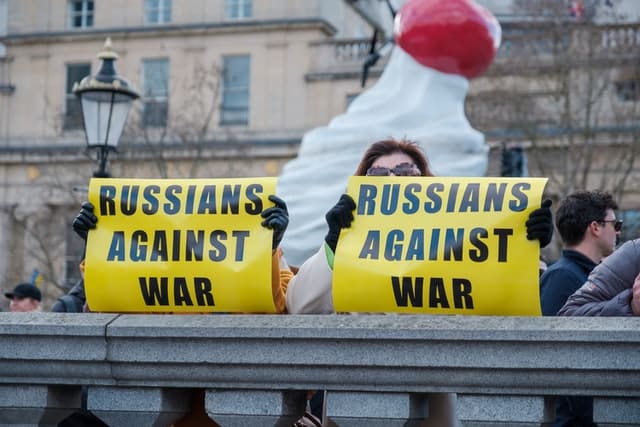[vc_row][vc_column][vc_column_text]Just five months of the war in Ukraine has cost Russia tens of thousands of casualties and tens of billions of dollars so far, according to U.S. authorities. But a Russian specialist sees deep and long-term damage to the Russian military even after the war ends. “I really see this just looking out into the future a couple of years here, the long-term effects of what this war is,” Dara Massicot, Senior Policy Researcher focusing on Russian defense issues at the RAND Corporation, tells Political IQ, “and it’s not a good story.”
Russian Military Struggling to Replenish Massive Losses
To date, the White House estimates that more than 75,000 Russian soldiers have been killed or wounded on the battlefield in Ukraine. Massicot notes the losses have hit over multiple ranks, from junior enlisted all the way up to the Generals, but she believes “real damage lives in those lower levels.” “I say that because those are the people who have enlisted or joined the military in the last 15 years or so when they really made a legitimate attempt at reform, modernization, trying to think about a new way forward in the 21st century. Those people, if they’re not killed or injured, there are signs that many of them are refusing to sign new contracts. They want to leave the military. They don’t want to be a part of it anymore.” Conscripts, especially, will become an issue for Russia. “Conscripts are a major source of professional enlisted soldiers, probably the most important source,” says Massicot. “So far it doesn’t seem like that’s happening in large numbers.” Russia is thus forced to use an “ad hoc approach” to replenish its front lines, she says. “They’re pulling from nine different pools right now to try to get people to fill the ranks, anything from volunteers to prison battalions to foreign fighters. There’s a hodgepodge of groups.”
Russia is Already Starting to Feel the Strain
Last week, the Pentagon held a background briefing, during which a Senior Military Official said of Putin, “We know that he is paying people. We know that he is contracting soldiers to stay who otherwise would not,” adding, “as a result I think what we’re seeing is their battlefield effectiveness in many cases is very poor.” The Official then gave an example, “I don’t know where I saw the video, but there was a video of a Russian tank just driving around in a circle. And it turned out it’s because the driver was not trained. He didn’t know how to drive the tank. It wasn’t because they were having fun in the tank.” “There’s reports they’re receiving minimal training at best, and that’s one to four weeks’ worth of training,” says Massicot. “They’re not combat ready, and every wave of replenishment that they’re going to put against this is going to be less effective than they had in the very beginning.”
Low Morale Plagues the Russian Military
Massicot is quick to note that the Ukrainians are also facing replenishment challenges. However, she adds, “The unit cohesion from what I understand on the Ukrainian side is much higher. The will to fight is much higher.” By contrast, there’s evidence of low morale plaguing the Russian military. This summer, Polish Foreign Intelligence intercepted Russian phone calls, on which soldiers express mounting frustration and refer to “Putin pressing on in his criminal war in Ukraine.” At one point a soldier says, “Dumb people are making stupid decisions because they thought the Ukrainians would kiss their feet.” “If those recordings are to be believed, morale is quite low,” says Massicot. “There’s this sense of exhaustion, a sense of disorganization, a sense of soldiers trying to stay alive to execute the orders that they’re given. I don’t know that that’s a recipe for success for this kind of major offensive.” “Russian soldiers do not know what they are fighting for. The goals of this war were vague from the very beginning and change every day,” wrote Yuri Yarim-Agaev, founder of the Center for Democracy during the former USSR in a recent op-ed. He added, “Propaganda still manages to hammer it into the heads of Russians, cutting off from the truth about the war. But that propaganda cannot stand the brutality of this war. It is difficult for soldiers inside Ukraine to believe in Moscow fairy tales.”
Russia Historically Not Equipped to Handle PTSD
And morale has potential to get much worse when reports of the Russian military committing war crimes and human atrocities in Ukraine are factored in. Massicot speculates that witnessing or being ordered to take part in these actions will leave lingering scars on individual soldiers. “They’re bringing all of that right back into the barracks, right back into their own homes,” she notes. She adds that Russian officials “do not have a rich history for caring for combat veterans and specifically the invisible wounds like PTSD.” While she admits she doesn’t have much insight into what’s happening in Russian military hospitals at the moment, “in the early 2000s you had this problem with Chechen veterans. There was little to no support for them with mental health issues.”
Slow-Paced Fighting a Plus and Minus for Russian Military
Since the war entered what’s considered its second phase this spring, it’s been a slow battle of attrition, narrowly focused in the Donetsk region, as opposed to Russia’s initial blitzkrieg-type of fast hits over the entirety of Ukraine. Massicot believes the drawn-out fighting is more sustainable for Russia. “When Russia can sit in one place and move slow, then they can use their quantitative advantages,” she says. “They can use the fact that their artillery out-ranges the Ukrainians’ in most cases with the exception of HIMARS. I think it does probably slow down their casualty rates.” However, the longer the war drags on, the more opportunity there is for the Western sanctions to damage Russia. According to a July 7 assessment by NATO, Russia’s Finance Minister, Anton Siluanov has confirmed that the “special operation” in Ukraine had so far required 8 trillion rubles ($120 billion). The NATO assessment added, “Sanctions are starting to bite and will set the Russian economy—which is not able to produce a huge range of goods without foreign technology or parts—back for decades.” “Russia retains the capacity to continue the war and is nowhere near collapse, but a long period of stringent sanctions could prove to be catastrophic for a state that seeks to be a great power,” wrote Dr. Nivedita Kapoor, former faculty member at the Higher School of Economics in Moscow.
This Could Be a Decades-long War
There’s speculation this war will not end until the reign of Vladimir Putin ends in Moscow—if then. “I think this may turn into a 20-year war that flares up for 18 months at a time, three or four times over a 20-year period,” said Professor Michael Clarke, former Director of the Royal United Services Institute in Australia. “This war lasts as long as Putin lasts and probably some time into his successor.” Massicot views Ukraine as a “long-term project for Russia” because it’s about regime change for the Kremlin. “I think as the years go by it gives them the chance to rest, refit, maybe take another swing at this,” she says. “And the same for the Ukrainians, too. If there’s a frozen conflict, it’s not something the Ukrainians want, certainly, but it would allow them time to regenerate, as well.”
Read more exclusive news from Political IQ.
[/vc_column_text][/vc_column][/vc_row][vc_row][vc_column][vc_raw_html]JTNDZGl2JTIwaWQlM0QlMjJjaGFsa2xpbmVfaWZyYW1lX2NvbnRhaW5lciUyMiUzRSUzQyUyRmRpdiUzRSUwQSUzQ3NjcmlwdCUyMHR5cGUlM0QlMjJ0ZXh0JTJGamF2YXNjcmlwdCUyMiUzRSUwQSUwOSUyOGZ1bmN0aW9uJTIwJTI4JTI5JTIwJTdCJTBBJTA5JTA5Y29uc3QlMjBjbGllbnRDb25maWclMjAlM0QlMjAlN0IlMEElMjAlMjAlMjAlMjAlMjAlMjAlMjAlMjAlMjAlMjAlMjAlMjAlMjAlMjAlMjAlMjBzZXJ2ZXIlM0ElMjAlMjdodHRwcyUzQSUyRiUyRmdhbWVzLnBvbGl0aWNhbGlxLmNvbSUyRiUyNyUyQyUwQSUyMCUyMCUyMCUyMCUyMCUyMCUyMCUyMCUyMCUyMCUyMCUyMCUyMCUyMCUyMCUyMHRhcmdldCUzQSUyMCUyN2NoYWxrbGluZV9pZnJhbWVfY29udGFpbmVyJTI3JTJDJTBBJTIwJTIwJTIwJTIwJTIwJTIwJTIwJTIwJTIwJTIwJTIwJTIwJTIwJTIwJTIwJTIwY29uZmlndXJhdGlvbiUzQSUyMCU3QiUwQSUwOSUwOSUwOSUwOWlzSGVhZGVyRW5hYmxlZCUzQSUyMHRydWUlMkMlMEElMjAlMjAlMjAlMjAlMjAlMjAlMjAlMjAlMjAlMjAlMjAlMjAlMjAlMjAlMjAlMjAlN0QlMEElMDklN0QlM0IlMEElMDklMEElMDl2YXIlMjBzY3JpcHQlMjAlM0QlMjBkb2N1bWVudC5jcmVhdGVFbGVtZW50JTI4JTI3c2NyaXB0JTI3JTI5JTNCJTBBJTA5c2NyaXB0LnNyYyUyMCUzRCUyMCU2MGh0dHBzJTNBJTJGJTJGZ2FtZXMucG9saXRpY2FsaXEuY29tJTJGaW50ZWdyYXRpb24lMkZlbWJlZC5qcyUzRnRzJTNEJTI0JTdCRGF0ZS5ub3clMjglMjklN0QlNjAlM0IlMDklMEElMDlzY3JpcHQudHlwZSUyMCUzRCUyMCUyN3RleHQlMkZqYXZhc2NyaXB0JTI3JTNCJTBBJTA5c2NyaXB0Lm9ubG9hZCUyMCUzRCUyMCUyOCUyOSUyMCUzRCUzRSUyMCU3QiUwQSUwOSUwOXdpbmRvdy5DaGFsa2xpbmVHYW1lcy5ib290c3RyYXAlMjhjbGllbnRDb25maWclMjklM0IlMEElMDklN0QlM0IlMEElMDklMEElMDlkb2N1bWVudC5ib2R5LmFwcGVuZENoaWxkJTI4c2NyaXB0JTI5JTNCJTBBJTA5JTdEJTI5JTI4JTI5JTNCJTBBJTNDJTJGc2NyaXB0JTNF[/vc_raw_html][/vc_column][/vc_row]


